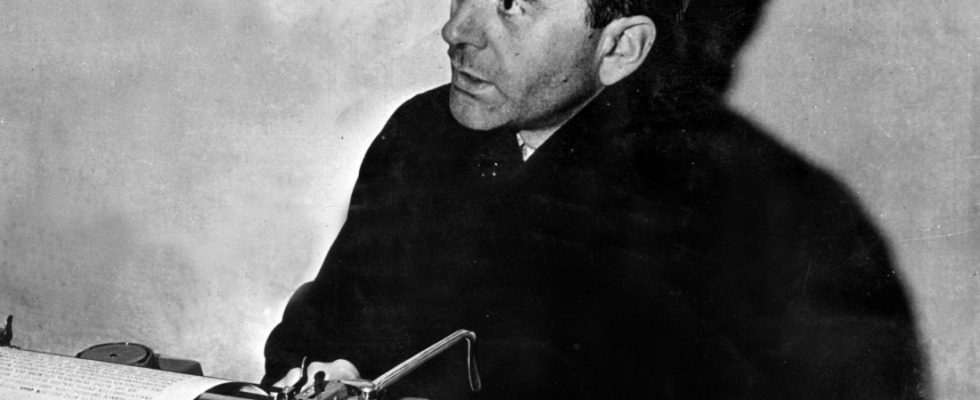Did he ever hear the name Auschwitz during this time? The man who was part of Adolf Hitler’s inner circle all these years, who was his star architect and the Nazi regime’s armaments minister from 1942, could expect that the contemporary historian and major journalist Joachim Fest would ask him this question. And Albert Speer had already had much longer to come up with answers after the Allies sentenced him to 20 years in prison as a war criminal. He replied in an interview with Fest in 1969 that he had “not directly heard” the name Auschwitz. And the Germans were satisfied: If Speer didn’t know anything, how did we?
Speer’s denials and lies, his constant glossing over and his constant “Oh, if only I had asked!” have long had an impact in Germany. Even in the Obersalzberg documentation, which opened in 1999, a section of the old permanent exhibition was titled the “strange emptiness” that, according to Speer, once existed at Obersalzberg. Accordingly, Hitler used to sleep here for a long time and therefore bored everyone even more with his monologues at night. The old permanent exhibition had already shown that the Obersalzberg was not an idyllic holiday home, but a place where crimes against humanity were planned and ordered. The current one in the new documentation building, which opened last fall, does this all the more. The first special exhibition has been on display there since Friday under the title “Albert Speer in the Federal Republic. Dealing with the German past”.
Martina Christmeier and Alexander Schmidt designed it in 2017 for the Nazi Party Rally Grounds Documentation Center in Nuremberg; it is based on the research of Magnus Brechtken. The deputy head of the Munich Institute for Contemporary History, which is also responsible for the content of the Obersalzberg documentation, also presented Speer’s first academic biography in 2017. On Thursday he opened the exhibition at Obersalzberg with a lecture.
It fits in almost perfectly with the permanent exhibition, also because the deputy documentary director Albert Feiber has added many details about Obersalzberg to the Speer show, which has already been shown at a handful of locations throughout Germany. Speer, who had been a member of the NSDAP since 1931 and always sought to be close to Hitler, had his permanent residence here in the “Führer restricted area” since 1938 at the latest. The house had previously belonged to a Jewish family. Most Berchtesgaden residents still call it “Speer House” – wrongly, as its current resident, the entrepreneur and local Green Party politician Bartl Wimmer, emphasizes.
Until the 1990s, people wanted to see and portray the Obersalzberg and thus the whole of Berchtesgaden as an unpolluted and innocent holiday idyll. Speer also suited the people of Berchtesgaden with his beautifully colored descriptions, in which he portrayed himself as a technocrat who was rather bothered by Hitler’s presence, but who allowed himself to be seduced by his aura.
Seven years ago in Nuremberg, curator Alexander Schmidt called for the old Speer books to be taken off the shelves. Several stacks of them are now part of the special exhibition at Obersalzberg.
(Photo: Matthias Köpf)
The exhibition also shows that the apparently good Nazi Speer met a grateful audience with his precisely calculated lies, which he told again and again since his release from prison in 1966. That is why thousands of books with his alleged memories were bought from the already very rich careerist and heir. Some stacks of them are now part of the exhibition. In 2017, curator Alexander Schmidt called for the old bestseller to be taken out of the cupboards and given to the Nuremberg Documentation Center. There were probably around 300 copies, says Schmidt – around a third of the amount of Speer books the same publisher still sells each year.
It wasn’t just the publisher Wolf Jobst Siedler or journalists like Fest who benefited from Speer. The vast majority of other journalists and historians also liked to rely on what he reported to them. Brechtken shows that sources that refute Speer’s lies were available early on. Because Speer knew it very well. He approved 13.7 million Reichsmarks for the expansion of Auschwitz, received detailed and illustrated reports and had concentration camp prisoners used for forced labor. But it was a young doctoral student named Matthias Schmidt who first discovered much of it. His dissertation was published in 1982, a year after Speer’s death. A former employee of Speer had made documents available to him – out of disappointment with Speer’s publicly emphasized renunciation of National Socialism.

